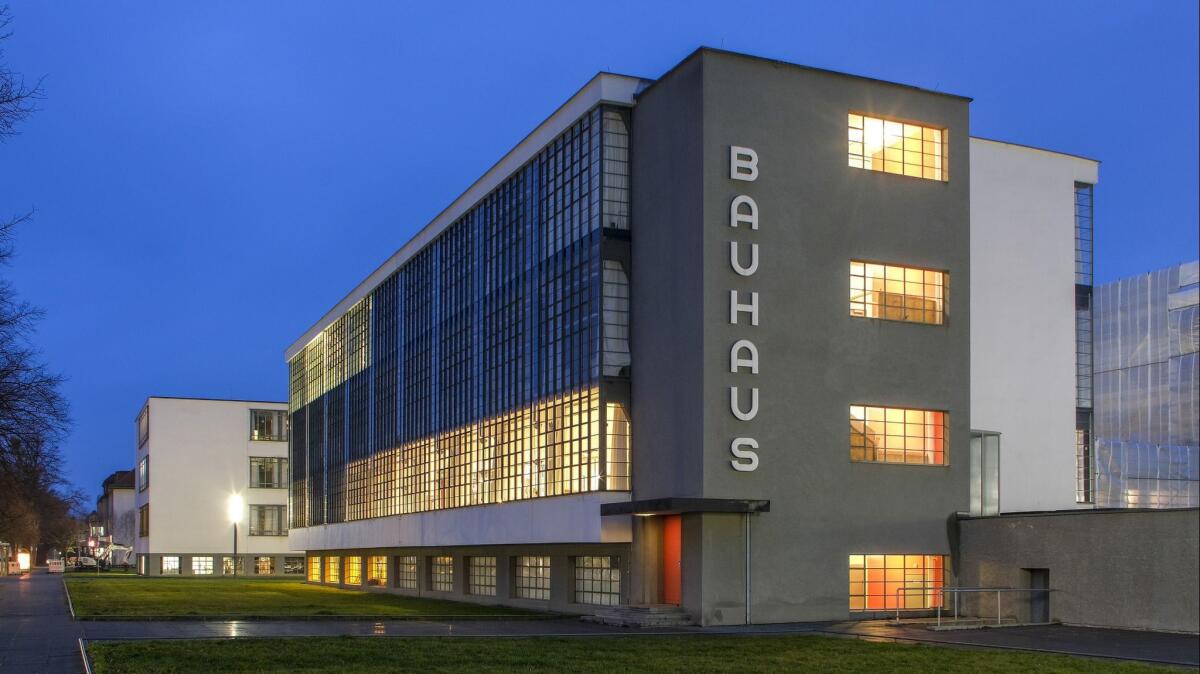Exploring the birthplace of Bauhaus, a German movement that changed design

- Share via
Reporting from Berlin — When I was a kid, anything 100 years old was an antique and looked as though it belonged in a museum or Great-Grandma’s house. So I was surprised when I realized that 2019 was the centenary of Bauhaus.
Marcel Breuer’s 1925 steel tube Wassily chair would fit nicely into my minimalist home office if I could afford it. And Marianne Brandt’s forever contemporary 1924 tea infuser would exponentially ramp up the chic of my kitchen.
The German cities of Weimar, Dessau and Berlin were home to Bauhaus, the trailblazing art, architecture and design school between 1919 and 1933, and they are celebrating this 100th anniversary with events throughout the year, including the opening of two new Bauhaus museums.
Bauhaus was the birthplace of modernism, and its concepts and philosophy quickly spread. Today, you can see the Bauhaus legacy in skyscrapers, prefabricated buildings, flat-roofed houses and skylights, as well as in Ikea’s aesthetically pleasing and functional products and even the layout of your iPhone screen.
Bauhaus binge
As a lifelong Bauhaus addict, I headed in May to the former East Germany to take a road trip and to join in some of the celebrations. I flew to Frankfurt, then drove the efficient autobahn through gentle rolling hills, bright yellow with canola fields.
After 2½ hours I arrived for my weeklong Bauhaus binge in charming Weimar, population 65,000, chosen after World War I as Germany’s first democratic capital. Although Germany was bankrupt, creativity and hope were booming because the country was ripe for change.
Thus Bauhaus was born in the cultural German hub of Weimar, home and popular haunt of classical heroes such as Goethe, Schiller, Bach, Nietzsche and Liszt.
I poked around the original Bauhaus University building, on the campus where art and design are still taught. In 1919 it was focused on minimalism and functionality, and decorative Old World styles such as Art Nouveau were discarded, a radical move.
Angular yellow upholstered armchairs sat atop a contemporary carpet of multicolored squares and triangles in the reconstructed office of Walter Gropius, the first Bauhaus University director. The only item that looked 100 was a black vintage telephone on the sleek, Scandinavian-style wooden desk.
In early April the first new Bauhaus museum opened in Weimar. Inside the white cube is a dizzying display of Bauhaus icons, the creations of students and instructors who worked on weaving, ceramics, metalwork, art, music, dance, photography, furniture, architecture and even typography.
“It was a completely new time, the dawn of a new life,” said Jayne Obst, my Bauhaus researcher guide.
We walked through parkland to the simple white Haus am Horn, a stylish one-story model home that was part of the extensive 1923 Bauhaus Exhibition to show off the school’s works to a population and state government increasingly displeased with their tax dollars funding this offbeat enterprise.
Although the event spread the word “Bauhaus” internationally, funding was slashed and the school closed the next year.
Bauhaus in Dessau
Fortunately, the industrial city of Dessau, a two-hour drive northeast, funded the new Bauhaus School beginning in 1926, and that’s where it blossomed into the most influential modernist art movement of the 20th century.
I took my time reaching Dessau. The object of my road trip was to explore by car the various towns, cities and villages in search of Bauhaus treasures. In lovely Jena, 14 miles away, I visited two Gropius villas and had a private tour of the spectacularly restored 1924 private Bauhaus residence called Haus Auerbach with its owner.
Fifty minutes away in the old city of Erfurt, I lingered over an insightful exhibition at the Angermuseum called 4 Bauhausmädels — 4 Bauhaus Gals — showcasing four creative female Bauhaus students and their very different and moving life stories at a time when women were experiencing a wave of freedom after World War I.
Halle, the birthplace of Baroque composer George Frideric Handel, 75 miles away, knocked me out with its diverse Bauhaus offerings: the Grossgarage, an astonishingly progressive, four-story glass-roofed 150-auto garage from 1929; a modernist industrial water tower; and the colorful, hexagonal Holy Trinity Catholic Parish Church.
Dessau, just 40 minutes away, was where Bauhaus reached its zenith when the school moved here in 1925. It’s also where it shifted its philosophy from combining art and craftsmanship to art and industry, which alienated many of its founding members but propelled the school into the future. The city was desperate for better housing for workers flocking to booming factories.
I strolled through the tranquil Gropius-designed housing complex of the Törten Estate, rows of modular, two-story, flat-roofed townhouses that are still occupied. Although each residence was small and simple, it had unheard-of 1920s luxuries such as hot water plumbing and central heating.
The houses that retain the original minimalist white exterior with its slim, two-story glass-brick “window” to illuminate the interior staircase appear far more modern than those more recently decorated with shutters, tiles, paneling and kitschy adornments.
Like most Bauhaus buildings I visited, this workers’ housing complex is part of the Bauhaus UNESCO World Heritage Site. Any exterior renovations must restore the unit to Gropius’ original design.
Dessau’s shining star, however, is Gropius’ stunning 1926 Bauhaus Building with its trademark steel grids and massive glass curtain wall that survived bombing in World War II. Invisible Places, a citywide installation, fills in blanks where Bauhaus buildings once stood.
The restored building and campus is now a research and teaching institution dedicated to furthering Bauhaus ideas. The interior is remarkable: light shifting through the huge windows, clean lines, splashes of signature Bauhaus red, yellow and blue, and railings crafted from water and gas pipes, a Bauhaus classic. For Bauhaus geeks like me, it’s a dream to overnight in the bright, simple students’ quarters and to dine in the minimalist canteen.
The Masters’ Houses, a short walk, include three pairs of identical semidetached houses for the Bauhaus masters and a detached single home for its director. For years they housed Europe’s leading contemporary artists such as László Moholy-Nagy, Paul Klee, Wassily Kandinsky and many others.
I needed a break so I hopped on the Bauhaus Bus that stops at all the town’s sites and headed for coffee and warm apple strudel at the Kornhaus, a circular 1930 Bauhaus glass gazebo/restaurant overlooking the Elbe River.
A trip to Japan with my teenage nephew leads to life lessons »
Dessau’s new Bauhaus Museum opens Sept. 8, with 49,000 objects, Germany’s second biggest Bauhaus collection after the Berlin Bauhaus Archives.
By 1932, Dessau’s Bauhaus School was closed amid rising political turmoil and the fallout from the 1929 financial crisis. It moved to Berlin, where German American architect Mies van der Rohe became its third and final director. But within a year Hitler closed it, claiming the movement was infiltrated with Jews and Communists.
Ironically, Nazi persecution hastened the spread of Bauhaus ideas because many of its instructors and most promising students fled Germany. Many went to Israel, where Tel Aviv’s White City is now a UNESCO World Heritage Site for its more than 4,000 Bauhaus buildings from the 1930s.

Gropius moved to Harvard’s Graduate School of Design; Moholy-Nagy founded the Chicago’s Illinois Institute of Technology’s school of design; and Mies van der Rohe became a celebrated Chicago architect.
My final stop was in Berlin, site of Gropius’ last major project, the 1960 Berlin Bauhaus Archives. The unusual building is being updated and the complex expanded; it will reopen in 2022 with Germany’s biggest Bauhaus collection. I finished my trip at the temporary archives nearby, checking out its centenary exhibition and picking up a souvenir in its wonderful Bauhaus Shop: a classic white teapot that I could take home and steep in modernism.

If you go
THE BEST WAY TO FRANKFURT, GERMANY
From LAX, Lufthansa and United offer nonstop service to Frankfurt, and United, Air Canada, KLM, American, British, Lufthansa and Delta offer connecting service (change of planes). Restricted round-trip airfare from $1,174, including taxes and fees.
Bauhaus Walking Tour, Bauhaus Atelier Info Shop Cafe, 6a Geschwister-Scholl-Strasse, Weimar, Germany. Current or former students of Weimar’s Bauhaus University offer walking tours of the original campus and the Haus am Horn. There is also an unguided audio-walk, “Where is Walter.”
Bauhaus by Bike. English guided group tours from two hours.
Bauhaus Dessau Foundation, 38 Gropiusallee, Dessau, Germany. Guided daily tours of the Bauhaus Building, the nearby Masters’ Houses and the Törten Estate workers’ housing project. A yearlong program of celebrations includes the opening of the new Dessau Bauhaus Museum on Sept. 8.
Overnighting in Dessau’s Bauhaus Studio Building. Stay in the Studio Building, which housed junior masters and promising students, for about $60 to $100 per night. No Wi-Fi; communal bathroom on each hall. Dine in the Bauhaus Canteen.
Bauhaus in Berlin. The city is celebrating the centenary with exhibitions and events. You can see the original building that is being reconstructed and expanded at 14 Klingelhoferstrasse or visit the temporary archive exhibit/shop at 1-2 Knesebeckstrasse.
Art: Berlin, 22 Bessemerstrasse, Berlin. Two-hour English-language Berlin Bauhaus tours from $27 per person.
TO LEARN MORE
Bauhaus UNESCO World Heritage sites
More to Read
Sign up for The Wild
We’ll help you find the best places to hike, bike and run, as well as the perfect silent spots for meditation and yoga.
You may occasionally receive promotional content from the Los Angeles Times.






